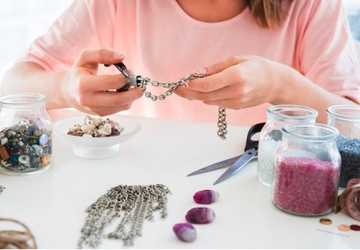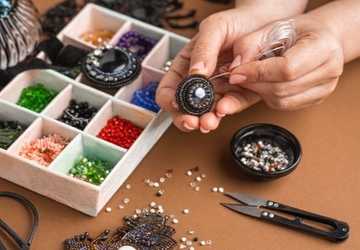How to Successfully Mix Jewelry Metals
Mixing jewelry metals is a stylish way to create a unique look and add versatility to your collection. However, achieving a consistent and beautiful look can be challenging. This guide offers practical tips on successfully mixing jewelry metals so that your accessories complement each other and enhance your overall style.
Understanding Jewelry Metals

Before diving into mixing metals, it's essential to understand the properties of different jewellery metals. Here are some common types:
Gold: Available in yellow, white, and rose, gold is a timeless and classic choice known for its durability and shine.
Silver: Known for its bright, shiny finish, silver is versatile and pairs well with many other metals. It's less expensive than gold and platinum but requires regular polishing to maintain its shine.
Platinum: A durable and rare metal with a cool, silvery look. Platinum is hypoallergenic, making it perfect for those with sensitive skin.
Copper: Its warm, reddish-brown colour adds a rustic touch to any look. Copper develops a natural patina over time, which can enhance its beauty.
Titanium and Stainless Steel: Both are strong and durable, and they are often used in modern and minimalist designs. Titanium is lightweight and hypoallergenic, while stainless steel tarnishes and resists corrosion.
Start With a Base Metal
When mixing metals, start with one dominant metal that will serve as the foundation of your look. This base metal should be the most eye-catching piece in your outfit. For example, if you prefer gold, make it the dominant metal and add other metals to complement it. Starting with a base metal creates a cohesive look and makes it easier to incorporate different pieces.
Pay Attention to The Balance
Balance is crucial when mixing metals. Avoid overloading one metal and neglecting the others. Aim for an even distribution of metals to create a harmonious look. For example, if you wear a gold necklace, consider adding a silver bracelet and a platinum ring to balance the overall effect.
Balance also applies to the size and weight of the pieces. Pairing a chunky gold bracelet with delicate silver earrings can create an imbalance. Instead, adjust the size and weight of the pieces to maintain a consistent look.
Use Statement Pieces
A statement piece can combine different metals to become the focal point of your outfit. This can be a statement necklace, an oversized ring, or a statement bracelet. Statement pieces can incorporate multiple metals and be easier to combine with other pieces. For example, a gold and silver necklace can act as a bridge, allowing you to wear gold and silver jewellery without clashing.
Consider the Occasion
The occasion plays a significant role in how you mix metals. For formal events, opt for a more subtle pairing with pieces that aren't too high-end. In contrast, casual occasions allow for more creativity and a wider combination of metals and styles. Always make sure the jewelry you choose fits the dress code and vibe of the event. For example, platinum and gold might work best for a formal occasion, while copper and silver might be more appropriate for a casual outing.
Play with Different Textures
Mixing metals isn't just about colour; it's also about texture. Combining smooth, polished pieces with rough, hammered ones can add depth and interest to your look. For example, a polished gold ring looks stunning when paired with a hammered silver bracelet, creating a unique contrast. Textured pieces can add a tactile element to your jewellery, making it visually appealing and stylish.
Layering is Key
Layering is an excellent technique for mixing metals. Start with delicate, simple pieces and gradually add more eye-catching pieces. Layering necklaces of different lengths from different metals can create a chic and sophisticated look. The key is to maintain a cohesive theme, whether that's through similar styles, shapes, or themes. For example, layering a gold chain with a silver pendant and a rose gold medallion can create a harmonious and layered effect.
Pay Attention to Proportion

When mixing jewellery metals, the proportion is important. Make sure the size and shape of your pieces are complementary. For example, pairing a chunky gold bracelet with a delicate silver ring can create an imbalance. Instead, mix thick with chunky and delicate with delicate for a well-proportioned look.
Proportion also extends to the length and size of necklaces, bracelets, and earrings. Keeping these proportions balanced ensures that each piece complements rather than competes with one another.
Pay Attention to Detail
Small details can make a big difference. Pay attention to the details of your jewelry, such as clasps, settings, and gemstones. Pieces with similar information can help tie different metals together. For example, if you have a gold chain with silver accents, it will certainly pair well with silver jewellery. Details like engravings, gemstone settings, and design elements can serve as a common thread that unifies your collection's different types of metals.
Experiment and Have Fun
Mixing metals is about expressing your style, so don't be afraid to experiment. Experiment with different combinations and find the one that works best for you. Fashion is subjective, and the most important thing is that you feel confident and comfortable with your choices. You can be creative and bold when mixing metals, so use this opportunity to show off your unique style.
Examples of Successful Mixing of Metals
To inspire you, here are some examples of successful metal mixing:
Classic Elegance: A yellow gold necklace paired with white gold earrings and a platinum bracelet creates a timeless, elegant look perfect for formal occasions.
Modern Minimalism: A titanium watch paired with a stainless steel bracelet and a simple silver ring creates a sleek, contemporary aesthetic. The clean lines and minimalist designs of these pieces complement each other perfectly.
Boho Chic: Layered copper necklaces, silver bracelets, and mixed metal rings create a bohemian, eclectic vibe. The combination of metals and textures creates a free-spirited and artistic look.
Caring for Your Mixed Metal Jewellery
To keep your mixed metal jewellery looking great, follow these care tips:
Store separately: Store different metals separately to avoid scratches and tarnishing. Use separate compartments in a soft pouch or jewellery box. This helps maintain the finish and integrity of each piece.
Clean regularly: Clean your jewellery regularly using a cleaning solution appropriate for each metal. Avoid harsh chemicals that can damage the finish. Regular cleaning will keep your jewellery looking like new.
Avoid water and chemicals: Remove jewellery before swimming, bathing, or using household cleaners to avoid corrosion and tarnishing. Water and chemicals can cause tarnishing and damage to metals.
Conclusion
Mixing jewelry metals is a great way to diversify your accessories collection and create a unique, personalized look. By understanding the properties of different metals, maintaining balance, and paying attention to detail, you can successfully mix metals and enhance your overall style.
Remember to explore and enjoy your choices because fashion is about showing off your unique personality. Mixing metals can create a stylish and cohesive look, whether you prefer classic elegance, modern simplicity, or bohemian chic.